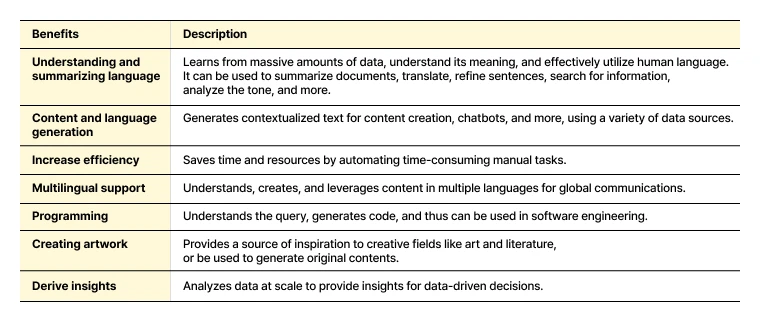The Importance of LLMs for Enterprises
Elice
09/05/2024
In the rapidly evolving field of natural language processing (NLP), large language models (LLMs) have transformed how computers interpret and generate human language. These models have seen widespread adoption in the AI industry, particularly following the success of ChatGPT, and are now integral to numerous applications.
Comparative analysis of two leading AI chatbots - watch now
What is an LLM?

A Large Language Model (LLM) builds upon the foundation of a Language Model (LM), which is an artificial intelligence model designed to understand and generate human language.
LLMs leverage deep learning techniques and consist of extensive neural networks where each element is self-attentive, enabling the analysis and comprehension of complex language structures, including grammar, syntax, and semantics. Due to these capabilities, LLMs trained on extensive datasets can produce responses that closely mimic human communication.
How LLM works

LLMs operate by analyzing the relationships between words. Traditional machine learning approaches convert each word into a numerical representation, often struggling to capture the nuances between words with similar meanings. LLMs address this by representing words as multidimensional vectors, known as word embeddings. These embeddings map the relationships between words, positioning words with similar or related meanings closer together. This approach allows LLMs to grasp the meaning of complex language and generate text that sounds as natural as human speech.
Benefits of an LLM

True to its name, an LLM can answer questions, summarize content, translate text, correct sentences, and much more. These capabilities can help businesses increase efficiency and leverage insights to enhance management and strategy.
Why an LLM for Enterprise
1. Leverage data-driven decisions

Large-scale language models have moved beyond the realm of IT departments and data experts, becoming accessible to every employee. They enable users to interpret corporate data and extract valuable insights through simple natural language queries. This democratization of data breaks down information silos, empowering the entire organization to make data-driven decisions.
For instance, marketing teams can directly use customer data to design campaigns, while sales teams can identify market trends and customer preferences to enhance their strategies. Ultimately, large-scale language models enhance enterprise data management and analytics, helping you achieve your business goals more strategically.
2. Deliver personalized customer support
Large-scale language models can also enhance customer interactions and boost satisfaction. By personalizing customer support and providing precise answers to inquiries, you can improve the customer experience. This approach helps strengthen brand trust and loyalty by ensuring quick and accurate assistance. Additionally, analyzing collected conversation data can lead to improved service quality and valuable business insights.
Many industries are leveraging enterprise AI for customer support, offering not just chatbots but also advanced product search capabilities for personalized service. For example, Elice uses AI to answer students’ coding questions in real time.
Get real-time help with AI Helpline - watch now
3. Use it as an effective brainstorming tool

An LLM in Enterprise can also inspire new ideas and approaches. For example, it can be used in product development or marketing to help generate ideas and inspire creative strategies based on existing market trends and consumer behavior. Marketing teams can feed LLM AI with market information and target audience characteristics to suggest effective ad campaign concepts, for example.
4. Create and manage content efficiently
With LLM AI, you can automate and streamline your content creation process. You can feed it topics, brand guidelines, and targeting information to generate new content. It can also be used to edit and summarize sentences, which helps make your content more readable.
Elice also offers a content creation AI service, which uses LLM AI to help you create content. It automatically generates quizzes based on your learning materials, contextualizes your learning materials, and helps you create and manage content efficiently.
Quickly organize training materials with Elice Content Creation AI - Watch now
5. Automate work smarter

Leverage large-scale language models to extract, categorize, and generate information to automate tasks. According to McKinsey, generative AI and technology can automate up to 70 percent of worker time, which can help automate repetitive tasks and ease the burden of prioritization, data entry, and summarization.
For example, Upstage’s Layout Analyzer enables the detection of document elements and recognition of relationships between paragraphs. This allows you to analyze the structure and content of a document, extract the necessary information, and organize it in a database. It also automates the search and extraction of business data, making it easier to draw insights.
Considerations for LLM adoption
1. Determine feasibility and need
You need to think about whether generative AI and large-scale language models are the most effective way to go. For example, Company A wants to build a product development strategy based on customer reviews. They want to analyze the sentiment of reviews to derive insights. In this case, it’s more effective to adopt an already developed machine learning model than a new LLM AI. On the other hand, if Company B is looking to introduce a chatbot service to respond to customer inquiries and is currently writing human responses every time, AI could be a good fit. In these situations, it’s important to look closely at the situation and determine what’s possible and necessary.
2. Determine the purpose of your technology adoption
If you want to make sure your LLM is the right fit, you first need to define clear business objectives. You need to evaluate what challenges you’re trying to solve and whether it’s the right vehicle to achieve your business goals.
For example, generative AI and large-scale language models are great for streamlining existing processes, extracting insights from data, or generating new ideas. Make sure your goals align with the benefits of AI for enterprise.
3. Consider the risks and benefits
Adopting enterprise AI and large-scale language models requires resources and investment, so you need to weigh the benefits of doing so against the risks of not getting the results you expect. It’s also worth checking that you’re not setting unrealistic goals.
Now you understand why an LLM is essential for your company: it can answer questions, summarize vast amounts of data, and optimize work processes, thereby enhancing productivity.
Elice offers services to help you develop an enterprise LLM. If you’re looking to implement generative AI and harness the full potential of AI in your business, we highly recommend consulting with us. Let Elice guide you through the adoption process and ensure you achieve the best outcomes for your organization.
Get an LLM customized for your organization - contact us now
*Elice owns the copyright to this content, which is protected under copyright law.
*Without prior consent, secondary processing and commercial use of the content are prohibited.
- #DX
- #LLM



